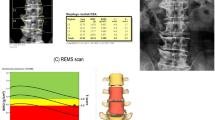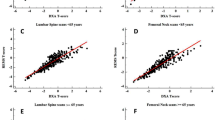Abstract
Summary
The bone health status of a Mexican female population, including a cohort of 455 women aged over 40 years, was assessed by Radiofrequency Echographic Multi Spectrometry (REMS).
Purpose
Assessment of the bone health status in an average female Mexican population with REMS. The secondary objective investigated age- and body mass index (BMI)–related effects on the diagnostic classification and the influence of risk factors for osteoporosis.
Methods
Women aged over 40 years underwent a REMS scan at the lumbar spine and both femoral necks. The degree of correlation of the bone mineral density (BMD) across axial sites was assessed by the Pearson correlation coefficient (r), along with the diagnostic discordance. The association between risk factors, age, and BMI and diagnostic classification was determined by the chi-squared test.
Results
Four hundred seventy-one women were enrolled. Osteoporosis was diagnosed in 11.0%, 8.1%, and 8.3% of cases at the lumbar spine and right and left femoral neck, respectively. The diagnostic agreement between the lumbar spine and femoral necks was about 73% (85% considering a 0.3 T-score tolerance), whereas the agreement between the femoral necks was 97.4% (99.6% considering a 0.3 T-score tolerance). Most of discordant cases were minor discordances. The correlation between the lumbar spine and femoral neck was r = 0.82 and 0.85, respectively, whereas both femoral necks correlated with r = 0.97. As expected, the prevalence of osteoporosis increased with age and decreased as BMI increased.
Conclusion
The widespread applicability of the non-ionizing REMS technology has been demonstrated in a representative Mexican cohort, covering wide age and BMI ranges. Age and BMI variations correlate with the prevalence of osteoporosis, in line with the recent scientific literature.



Similar content being viewed by others
References
Cruz GI, Cisneros DF, Salazar PR, Tejeida LA (2002) Costos institucionales y dificultades en la atención de los pacientes con fracturas por osteoporosis. Acta Ortop Mex 16(6):292–295
Diagnóstico y tratamiento de osteoporosis en mujeres posmenopáusicas. Guía de Evidencias y Recomendaciones: Guía de Práctica Clínica. México, CENETEC; 2018.
Clark FP, Carlos C, Barrera J, Guzman A, Maetzel P, Lavielle P et al (2008) Direct costs of osteoporosis and hip fracture: an analysis for the Mexican healthcare system. Osteoporos Int 19:269–276
Fuggle NR, Curtis EM, Ward KA, Harvey NC, Dennison EM, Cooper C (2019) Fracture prediction, imaging and screening in osteoporosis. Nat Rev Endocrinol 15(9):535–547. https://doi.org/10.1038/s41574-019-0220-8
El Maghraoui A, Achemlal L, Bezza A (2006) Monitoring of dual-energy X-ray absorptiometry measurement in clinical practice. J Clin Densitom 9(3):281–286. https://doi.org/10.1016/j.jocd.2006.03.014
Link TM, Kazakia G (2020) Update on imaging-based measurement of bone mineral density and quality. Curr Rheumatol Rep 22(5):13. https://doi.org/10.1007/s11926-020-00892-w
Bolotin HH (2007) DXA in vivo BMD methodology: an erroneous and misleading research and clinical gauge of bone mineral status, bone fragility, and bone remodelling. Bone 41(1):138–154. https://doi.org/10.1016/j.bone.2007.02.022
Tothill P, Hannan WJ (2007) Precision and accuracy of measuring changes in bone mineral density by dual-energy X-ray absorptiometry. Osteoporos Int 18(11):1515–1523. https://doi.org/10.1007/s00198-007-0382-4
Messina C, Bandirali M, Sconfienza LM, D’Alonzo NK, Di Leo G, Papini GD, Ulivieri FM, Sardanelli F (2015) Prevalence and type of errors in dual-energy x-ray absorptiometry. Eur Radiol 25(5):1504–1511. https://doi.org/10.1007/s00330-014-3509-y
Albano D, Agnollitto PM, Petrini M, Biacca A, Ulivieri FM, Sconfienza LM, Messina C (2021) Operator-related errors and pitfalls in dual energy X-ray absorptiometry: how to recognize and avoid them. Acad Radiol 28(9):1272–1286. https://doi.org/10.1016/j.acra.2020.07.028
Diez-Perez A, Brandi ML, Al-Daghri N, Branco JC, Bruyère O, Cavalli L, Cooper C, Cortet B, Dawson-Hughes B, Dimai HP, Gonnelli S, Hadji P, Halbout P, Kaufman JM, Kurth A, Locquet M, Maggi S, Matijevic R, Reginster JY, Rizzoli R, Thierry T (2019) Radiofrequency Echographic Multi-Spectrometry for the in-vivo assessment of bone strength: state of the art-outcomes of an expert consensus meeting organized by the European Society for Clinical and Economic Aspects of Osteoporosis, Osteoarthritis and Musculoskeletal Diseases (ESCEO). Aging Clin Exp Res 31(10):1375–1389. https://doi.org/10.1007/s40520-019-01294-4
De Marco T, Peccarisi M, Conversano F, Greco A, Chiozzi S, De Pascalis F et al (2016) A new approach for measuring the trabecular bone density through the echosound backscattering: an ex vivo validation on human femoral heads. Measurement 87:51–61
Aventaggiato M, Conversano F, Pisani P, Casciaro E, Franchini R, Lay-Ekuakille A, et al. (2015) Validation of an automatic segmentation method to detect vertebral interfaces in ultrasound image. IET Sci:1–10.
Pisani P, Greco, Conversano F, Renna MD, Casciaro E, Quarta L, Costanza D, Muratore M, Casciaro S (2017) A quantitative ultrasound approach to estimate bone fragility: a first comparison with dual X-ray absorptiometry. Measurement 101:243–249. https://doi.org/10.1016/j.measurement.2016.07.033.
Tomai Pitinca MD, Fortini P, Gonnelli S, Caffarelli C (2021) Could Radiofrequency Echographic Multi-Spectrometry (REMS) overcome the limitations of BMD by DXA related to artifacts? A series of 3 cases. J Ultrasound Med 40(12):2773–2777. https://doi.org/10.1002/jum.15665
Di Paola M, Gatti D, Viapiana O, Cianferotti L, Cavalli L, Caffarelli C et al (2019) Radiofrequency Echographic Multispectrometry compared with dual X-ray absorptiometry for osteoporosis diagnosis on lumbar spine and femoral neck. Osteoporos Int 30(2):391–402
World Health Organization (1994) Assessment of fracture risk and its application to screening for postmenopausal osteoporosis. Report of a WHO Study Group. World Health Organ Tech Rep Ser 843:1–129
Obesity: preventing and managing the global epidemic. Report of a WHO consultation. World Health Organ Tech Rep Ser. 2000;894:i-253.
Clark P, Carlos F, Vázquez Martínez JL (2010) Epidemiology, costs and burden of osteoporosis in Mexico. Arch Osteoporos 5:9–17. https://doi.org/10.1007/s11657-010-0042-8
Clark P, Cons-Molina F, Deleze M et al (2009) The prevalence of radiographic vertebral fractures in Latin American countries: the Latin American Vertebral Osteoporosis Study (LAVOS). Osteoporos Int 20(2):275–282. https://doi.org/10.1007/s00198-008-0657-4
Aziziyeh R, Amin M, Habib M et al (2019) The burden of osteoporosis in four Latin American countries: Brazil, Mexico, Colombia, and Argentina. J Med Econ 22(7):638–644. https://doi.org/10.1080/13696998.2019.1590843
Barquera Cervera S, Campos-Nonato I, Rojas R, Rivera J (2010) Obesidad en México: epidemiología y políticas desalud para su control y prevención [Obesity in Mexico: epidemiology and health policies for its control and prevention]. Gac Med Mex 146(6):397–407
Bojincă VC, Popescu CC, Decianu RD et al (2019) A novel quantitative method for estimating bone mineral density using B-mode ultrasound and radiofrequency signals-a pilot study on patients with rheumatoid arthritis. Exp Ther Med 18(3):1661–1668. https://doi.org/10.3892/etm.2019.7746
Khu A, Sumardi M (2020) A REMS scan-based report on relation between body mass index and osteoporosis in urban population of Medan at Royal Prima Hospital. Majalah Kedokteran Bandung 52:22–27. https://doi.org/10.15395/mkb.v52n1.1827
Xiao Z, Tan Z, Shang J, et al. (2020) Sex-specific and age-specific characteristics of body composition and its effect on bone mineral density in adults in southern China: a cross-sectional study. BMJ Open. 10(4):e032268. Published 2020 Apr 19. https://doi.org/10.1136/bmjopen-2019-032268
Huang D, Wang Y, Lv J, et al. (2020) Proteomic profiling analysis of postmenopausal osteoporosis and osteopenia identifies potential proteins associated with low bone mineral density. PeerJ 8:e9009. Published 2020 Apr 14. https://doi.org/10.7717/peerj.9009.
Boschitsch EP, Durchschlag E, Dimai HP (2017) Age-related prevalence of osteoporosis and fragility fractures: real-world data from an Austrian Menopause and Osteoporosis Clinic. Climacteric 20(2):157–163. https://doi.org/10.1080/13697137.2017.1282452
Rao AD, Reddy S, Rao DS (2000) Is there a difference between right and left femoral bone density? J Clin Densitom 3(1):57–61. https://doi.org/10.1385/jcd:3:1:057
Mounach A, Rezqi A, Ghozlani I, Achemlal L, Bezza A, El Maghraoui A (2012) Prevalence and risk factors of discordance between left- and right-hip bone mineral density using DXA. ISRN Rheumatol 2012:617535. https://doi.org/10.5402/2012/617535
Lee J, Lee S, Jang S, Ryu OH (2013) Age-related changes in the prevalence of osteoporosis according to gender and skeletal site: the Korea National Health and Nutrition Examination Survey 2008–2010. Endocrinol Metab (Seoul) 28(3):180–191. https://doi.org/10.3803/EnM.2013.28.3.180
Woodson G (2000) Dual X-ray absorptiometry T-score concordance and discordance between the hip and spine measurement sites. J Clin Densitom 3(4):319–324. https://doi.org/10.1385/jcd:3:4:319
Moayyeri A, Soltani A, Tabari NK, Sadatsafavi M, Hossein-Neghad A, Larijani B (2005) Discordance in diagnosis of osteoporosis using spine and hip bone densitometry. BMC Endocr Disord. 5(1):3. Published 2005 Mar 11. https://doi.org/10.1186/1472-6823-5-3
El Maghraoui A, Mouinga Abayi DA, Ghozlani I et al (2007) Prevalence and risk factors of discordance in diagnosis of osteoporosis using spine and hip bone densitometry. Ann Rheum Dis 66(2):271–272. https://doi.org/10.1136/ard.2006.062372
Mounach A, Abayi DA, Ghazi M et al (2009) Discordance between hip and spine bone mineral density measurement using DXA: prevalence and risk factors. Semin Arthritis Rheum 38(6):467–471. https://doi.org/10.1016/j.semarthrit.2008.04.001
Dey M, Bukhari M (2019) Predictors of fragility fracture and low bone mineral density in patients with a history of parental fracture. Osteoporos Sarcopenia 5(1):6–10. https://doi.org/10.1016/j.afos.2019.03.001
Office of the Surgeon General (US). Bone health and osteoporosis: a report of the surgeon general. Rockville (MD): Office of the Surgeon General (US); 2004. 8, Assessing the Risk of Bone Disease and Fracture. Available from: https://www.ncbi.nlm.nih.gov/books/NBK45525/
Morin SN, Lix LM, Leslie WD (2014) The importance of previous fracture site on osteoporosis diagnosis and incident fractures in women. J Bone Miner Res 29(7):1675–1680. https://doi.org/10.1002/jbmr.2204
Choi HS, Park JH, Kim SH, Shin S, Park MJ (2017) Strong familial association of bone mineral density between parents and offspring: KNHANES 2008–2011. Osteoporos Int 28(3):955–964. https://doi.org/10.1007/s00198-016-3806-1
Kelly PJ, Eisman JA, Sambrook PN (1990) Interaction of genetic and environmental influences on peak bone density. Osteoporos Int 1(1):56–60. https://doi.org/10.1007/BF01880417
Goodman SB, Jiranek W, Petrow E, Yasko AW (2007) The effects of medications on bone. J Am Acad Orthop Surg 15(8):450–460. https://doi.org/10.5435/00124635-200708000-00002
Adami G, Arioli G, Bianchi G et al (2020) Radiofrequency Echographic Multi Spectrometry for the prediction of incident fragility fractures: a 5-year follow-up study. Bone 134:115297. https://doi.org/10.1016/j.bone.2020.115297
Cortet B, Dennison E, Diez-Perez A, Locquet M, Muratore M, Nogués X, Ovejero Crespo D, Quarta E, Brandi ML (2021) Radiofrequency Echographic Multi Spectrometry (REMS) for the diagnosis of osteoporosis in a European multicenter clinical context. Bone 143:115786. https://doi.org/10.1016/j.bone.2020.115786
Amorim DMR, Sakane EN, Maeda SS, Lazaretti Castro M. New technology REMS for bone evaluation compared to DXA in adult women for the osteoporosis diagnosis: a real-life experience. Arch Osteoporos;16(1):175. https://doi.org/10.1007/s11657-021-00990-x.
Author information
Authors and Affiliations
Corresponding author
Ethics declarations
Conflicts of interest
None.
Additional information
Publisher’s note
Springer Nature remains neutral with regard to jurisdictional claims in published maps and institutional affiliations.
Supplementary Information
Below is the link to the electronic supplementary material.
Rights and permissions
About this article
Cite this article
Sergio, RO., Nayelli, R.G.E. Evaluation of the bone mineral density in the Mexican female population using the Radiofrequency Echographic Multi Spectrometry (REMS) technology. Arch Osteoporos 17, 43 (2022). https://doi.org/10.1007/s11657-022-01080-2
Received:
Accepted:
Published:
DOI: https://doi.org/10.1007/s11657-022-01080-2




